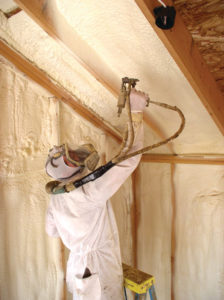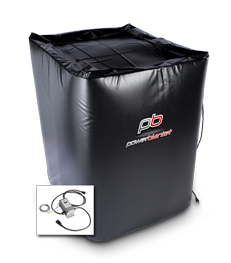 Congratulations! You’ve done your research and now understand the benefits of using spray foam insulation vs. old school fiberglass batts. You understand the economical benefits to their budget by using spray foam; it creates an airtight seal which is more efficient at keeping warm air inside during the winter and hot air out during the summer months, thus reducing their overall energy bill. Now, it falls on your shoulders to make sure you install the high quality insulation you are expecting.
Congratulations! You’ve done your research and now understand the benefits of using spray foam insulation vs. old school fiberglass batts. You understand the economical benefits to their budget by using spray foam; it creates an airtight seal which is more efficient at keeping warm air inside during the winter and hot air out during the summer months, thus reducing their overall energy bill. Now, it falls on your shoulders to make sure you install the high quality insulation you are expecting.
Educate Yourself
There are several spray foam training programs available to home owners and contractors to help. We recommend finding one in your area or attending an industry conference. Whether you’re brand new to spray foam or a veteran in the industry, there isn’t a better time than now to increase your knowledge and techniques.
However, sometimes you’re in the middle of a project and can’t leave to take a class. Here’s a handy guide to help you remember what you need to know when installing spray foam.
What Spray Foam Should I Use?
Spray Polyurethane Foam falls into two categories: closed cell and open cell.
MEDIUM-DENSITY CLOSED-CELL SPRAY FOAM
Medium-density closed-cell spray foam is dense and rigid. It boasts some pretty impressive properties and benefits. For example, its r-value (thermal resistance) ranges from about 5-6.5 per inch. By comparison, the r-value of traditional fiberglass insulation is about 3-4 per inch. Additionally, when installed at a thickness of at least two inches, it becomes a barrier to both air and vapor transfer. This prevents heat transfer via air and mold or mildew issues that can arise from unwanted moisture. Also, closed-cell spray foam rigidity makes it an excellent option or exposed walls or other exposed applications. It’s durable enough to hold up against regular wear and tear without needing repair. The drawback is that closed-cell foam can be difficult to work with due to its lack of malleability once dried.
LIGHT-DENSITY OPEN-CELL SPRAY FOAM
Light-density open-cell spray foam is semi-rigid. It holds its shape extremely well with its sponge-like consistency. As the foam expands and dries, it creates small open cells that fill with CO2. While its r-value is not as high as closed-cell foam, it still has great thermal resistance properties with an r-value around 3.2-3.8 per inch. When applied in a thickness of at least three inches, it acts as an air barrier. Unlike its closed-cell counterpart, open-cell foam cannot become a vapor barrier. While not quite as thermally resistant as closed-cell foam, open-cell spray foam is more sound-dampening due to lower density and increase in thickness.
When determining which spray foam is best, you have to look at what you’re using them for. Closed-cell spray foam is better served for the outer walls of a home since it keeps moisture and air out. However, that doesn’t mean open-cell spray foam is worthless. It’s best used as a sound deterrent, keeping the noise outside where it belongs.
Which Spray Foam Gun is Best?
Spray foam guns are alike in most ways in terms of how well they shoot foam. The difference between most products is the way excess spray foam exits the gun from the chemical mixing chamber. It’s really up to a personal preference for which one to use.
- Air Purge – A puff of air cleans out what foam remains from the mixing chamber.
- Solvent Purge – A cleaning solvent flushes out the mixing chamber after each blast of spray foam. According to InTech Equipment, this type of spray foam gun is most often used “for polyurea and two-part urethane coating applications.”
- Mechanical Purge – A valve within the mixing chamber prevents chemicals from combining until they are shot out of the spray gun.
How Long Does it Take to Apply Spray Foam?
Obviously, the answer to this question is based on the size of the insulation project you’re working on. A small wall will take only an hour or two to completely cover with a few inches of spray foam, moving the spray gun up and down in even columns. Remember, you need to lay down at least two inches for closed-cell spray foam and a minimum of three inches for open-cell.
Projects that are the size of a basement or attic usually will take most of a day, if not all of it. An entire house could take up to a week depending on how many rooms need to have full-on insulated walls.
Important Things to Remember with Spray Foam
- Quality Control – You must have at least a simple quality control program to ensure consistency across insulation projects. If your focus doesn’t start here, your business won’t succeed.
- Good Form – Consistent spray control must be used to avoid large gaps in spray foam.
- Correct Mix – Your spray insulation ingredients will make or break your project. Proper care should be taken by frequently checking the mix ratio of your proportioners, pumps and sprayers. Incorrect mix ratios can diminish the R-value, performance, and longevity of the spray foam.
- Temperature Control – Just as the correct mix is critical, the correct application temperature must also be maintained in order to ensure high performance. However, that’s not the only reason to pay attention to temperature control. The yield of your spray foam can decrease if the foam is too cold. Inconsistent and excessive localized heat can result in burned product. This affects your bottom line and the profitability of your projects.

Solutions For SPF Temperature Problems
For temperature control, Powerblanket recommends an insulated heating blanket. Some advantages of the insulated blanket over the “strap” or “band” type heaters are:
- Lower energy usage (heats your product, not the air)
- More even heat (more surface area for your product to absorb the heat)
- Heats the entire drum which means less heat damage to your product
- The ambient conditions have less effect (more effective in cold climates)
Using a heating blanket is guaranteed to help your spray foam maintain its nominal temperature. Use Powerblanket’s spray foam heaters and our other products to complete your tasks efficiently and on time.
Frequently Asked Questions
Can I spray foam insulate myself?
Yes, you can spray foam insulate yourself, but it's crucial to remove drywall before application to prevent the expanding foam from exerting pressure on the plasterboard.
Can you buy spray foam and do it yourself?
Yes, DIY spray foam insulation kits are available and are ideal for small projects like sheds or exposed walls, typically covering areas smaller than 400 square feet.
Is it cheaper to DIY spray foam insulation?
DIY spray foam insulation can be cost-effective for small projects, but for larger areas, hiring a professional may be more economical due to the high cost of materials.
What are the negatives of spray foam?
While spray foam insulation is effective for temperature control, it can pose challenges such as potential health risks, environmental concerns, and complications with home valuation and ventilation.
Keep your business running smoothly through the cold winter months with Powerblanket spray foam heaters.


